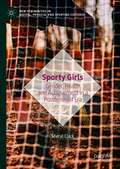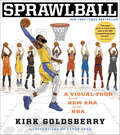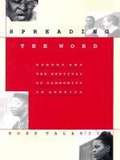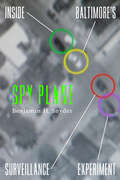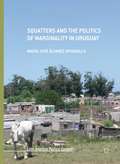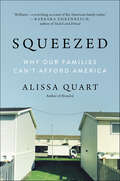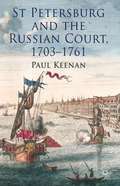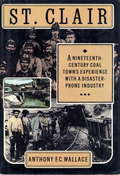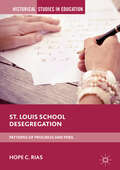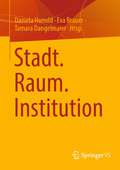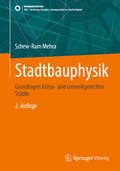- Table View
- List View
Sportswomen’s Apparel Around the World: Uniformly Discussed (New Femininities in Digital, Physical and Sporting Cultures)
by Linda K. FullerThis volume presents a collection of essays that explore the relationship between sporting clothing and gender. Drawing on uniform and sports apparel as a means of exploring the socio-sexual politics of the contemporary world, the contributions analyse the historical, political-economic, socio-cultural and sport-specific dimensions of gendered clothing in sport. Part of a two-volume series (the other discussing this phenomenon in the USA), contributors cover topics such as the rise of athleisurewear, Olympics outfits, eSports, religious considerations, the saree, fitness attire on Instagram, Japanese bloomers, youth clothing, ForPlay’s sexy sports costumes, and women’s sportswear for rugby, tennis, throwing, biking, wrestling, and flat track roller derby. This global anthology will be of interest to practitioners and scholars of sports history, the sociology of sport, and gender/media studies.
Sportswomen’s Apparel in the United States: Uniformly Discussed (New Femininities in Digital, Physical and Sporting Cultures)
by Linda K. FullerThis volume presents a collection of essays that explore the relationship between sporting clothing and gender. Drawing on uniform and sports apparel as a means of exploring the socio-sexual politics of contemporary US society, the contributions analyse the historical, political-economic, socio-cultural and sport-specific dimensions of gendered clothing in sport.Part of a two-volume series (the other discussing this phenomenon in a global context), contributors cover topics such as WNBA uniform politics, military promotion, female sportscaster clothing, magazine depictions, plus-size exercise apparel, FloJo, the Skirt Chaser 5k race, and the socio-politics of the LPGA, CrossFit, roller derby, rock climbing, and more. As the first single compendium to discuss American sportswomen’s apparel, this collection will be of interest to practitioners and scholars of sports history, the sociology of sport, and gender/media studies.
Sportverbände im Neokorporatismus: Eine empirische Studie über staatlich geförderte Projekte zum ‘Sport mit Geflüchteten’ in Deutschland (Sport – Gesellschaft – Kultur)
by Anne RübnerDie vorliegende Arbeit setzt sich als explorative, qualitative Fallstudie theoriegeleitet und empirisch mit der Entstehung staatlich geförderter Projekte zum ‘Sport mit Geflüchteten’ in Sportdachverbänden im Rahmen der Geflüchtetenkrise 2015/2016 auseinander. Über eine Rekonstruktion und Tiefenanalyse der Entstehungs-, Entwicklungs- Umsetzungs- und Verarbeitungsprozesse der Projekte werden diese nachvollzogen, darin angelegte Mechanismen identifiziert und damit zusammenhängende Auswirkungen herausgearbeitet. Als heuristischer Analyse- und theoretischer Bezugsrahmen dient das akteurtheoretische Erklärungsmodell mit dem darin konzeptualisierten Wechselverhältnis von sozialem Handeln und sozialen Strukturen. Als weitere Folie zur Beschreibung und Einordnung der staatlich-verbandlichen Interaktionen wird der Neokorporatismus-Ansatz herangezogen und in den akteurtheoretischen Rahmen integriert, indem wesentliche Elemente mit den akteurtheoretischen Komponenten (Strukturen, Handlungsmodi, Akteurkonstellationen etc.) begrifflich gefasst und konzeptualisiert werden. In dem Zusammenhang werden Fragen nach dem konkreten Outcome der neokorporatistischen Tauschlogik im Rahmen der Staat-Sportdachverbände-Beziehung oder nach dem Verbandshandeln im Spannungsverhältnis von Mitgliedschafts- und Einflusslogik nachgegangen. Darüber hinaus werden die Auswirkungen und Konsequenzen dieser neokorporatistischen Verflechtungen auf Grundlage der Untersuchungsergebnisse herausgearbeitet und reflektiert.
Sporty Girls: Gender, Health and Achievement in a Postfeminist Era (New Femininities in Digital, Physical and Sporting Cultures)
by Sheryl ClarkThis book engages with the ongoing question of why many girls stop doing sport and physical activity in their teenage years. Previous research has found that many girls’ disengagement from sport takes place despite their childhood enjoyment and that frequently these same women take up sport again as adults. Within these chapters, Sheryl Clark explores what it is about this period of time that persuades many girls to disengage from sports when their male peers continue to take part; why some girls continue to take part; and most importantly how girls understand this participation. She suggests that girls’ participation in sport should be viewed as part of their ongoing constructions of ‘successful girlhood’ within a competitive schooling system and broader socioeconomic context.
Sprachaneignung bei Geflüchteten: Individuelle und institutionelle Einflussfaktoren sowie die Wirkung von integrationspolitischen Maßnahmen
by Andreea Baier-KlenkertGeflüchtete verfügen im Vergleich zu anderen Migrationsgruppen über andere Erfahrungen und individuelle Voraussetzungen zur Sprachaneignung, weshalb eine Vielzahl neuer und zielgruppenspezifisch ausgerichteter Angebote von staatlicher Seite zur Sprachförderung geschaffen wurden. Die Arbeit beschäftigt sich mit der Frage nach dem Einfluss von jenen individuellen und institutionellen Faktoren und dem kausalen Effekt zur Wirkung von integrationspolitischen Maßnahmen und Maßnahmenketten auf die Sprachaneignung von Geflüchteten. Das theoretische Fundament der Arbeit bilden der Rational-Choice-Ansatz, der akteurzentrierte Institutionalismus sowie theoriebasierte Evaluationsansätze, die verknüpft und konzeptionell erweitert werden, um der Spezifität des Untersuchungsgegenstandes gerecht zu werden. Die Analysen belegen, dass individuelle Einflussfaktoren die Sprachaneignung von Geflüchteten zwar maßgeblich beeinflussen, aber auch institutionelle Faktoren bedeutende Faktoren darstellen. Weiterhin zeigt sich, dass integrationspolitische Maßnahmen und Maßnahmenketten zur Sprachaneignung bei Geflüchteten kausal wirken.
Sprawlball: A Visual Tour of the New Era of the NBA
by Kirk GoldsberryFrom the leading expert in the exploding field of basketball analytics, a stunning infographic decoding of the modern NBA: who shoots where, how well, and why. Says Nate Silver: “If you want to understand how the modern NBA came to be, you’ll need to read this book.” The field of basketball analytics has leaped into overdrive thanks to Kirk Goldsberry, whose spatial and visual analyses of players, teams, and positions have helped us all understand who really is the most valuable player at any position. SprawlBall combines stunning visuals, in-depth analysis, behind-the-scenes stories, and gee-whiz facts to chart a modern revolution. Since the introduction of the three-point line, the game has changed drastically, with players like Steph Curry and James Harden leading the charge. In chapters like “The Geography of the NBA,” “The Interior Minister (LeBron James),” “The Evolution of Steph Curry,” and “The Investor (James Harden),” Goldsberry explains why today’s on-court product—with its emphasis on shooting, passing, and spacing—has never been prettier or more democratic. And it’s never been more popular. For fans of Bill Simmons and FreeDarko,SprawlBall presents a bold new vision of the game, giving readers an innovative, cutting-edge look at the sport based on the latest research, as well as a visual and infographic feast for fans. ¶“Beautifully illustrated and sharply written, SprawlBall is both a celebration and a critique of the three-point shot. If you want to understand how the modern NBA came to be, you’ll need to read this book.” —Nate Silver, editor, fivethirtyeight.com, and bestselling author of The Signal and the Noise
Spreading the Word: Poetry and the Survival of Community in America
by Ross TalaricoIn 1985 poet Ross Talarico began a grassroots program in creative expression in Rochester, New York. As the program came together, so did the community--young and old, poor and privileged, even those who could not read or write but wanted to tell their stories. This book is a testimony to the poetry that experience produced. An exhilarating account of a successful experiment in promoting community self-expression, Spreading the Word interweaves the participants' stories with Talarico's own life, his struggle as a poet, and the drama of his workshops. The book will be both a resource and an inspiration for teachers of writing, writers, and those who simply wish to learn to write.Drawing on his workshops in Rochester, Talarico describes a unique approach for eliciting poetry from people of many ages and backgrounds--particularly underpriviledged urban kids and the elderly. The process--from dialogue to self-expression to publication to public event--illuminates the urgency and meaning of releasing the spirit captured in each man and woman and child's experience. "Some people say that Ross Talarico has done the impossible," the Today Show remarked of his success in Rochester; and with this book Talarico offers the same opportunity to others. Teachers, community leaders, parents, and children will be able to follow his practical, hands-on approach to encouraging self-expression in diverse, even unlikely, settings. They will see here how poetry is indeed relevant, ever more crucial to our identity as the culture evolves--how it is, finally, the place where the inarticulate can come to speak for themselves.
Sprechen Sie für sich
by Monika RadeckiDieses Buch zeigt Ihnen als Fach- und Führungskraft, wie Sie selbstbewusst Öffentlichkeit in eigener Sache herstellen, ohne sich zu verbiegen. Um Einfluss zu nehmen, Ihren Berufserfolg zu steigern und Mitarbeiter und Teams zu motivieren. Lernen Sie Ihre vielfältigen Seiten kennen, Ihre Anliegen wertschätzend am Gegenüber orientiert zu präsentieren, Ihre Leistung auf angemessene Weise ins rechte Licht zu rücken und Ihre Themen zu platzieren. Begrüßen Sie dabei innere Widerstände, und erkennen Sie die positiven Zeichen von Gegenwind. Der Leitfaden ist geeignet als Führungs- und Teamentwicklungstool, als Karriereinstrument, als Anregung zur Selbstreflexion in Zeiten ständiger Veränderung. Ein Buch mit vielen Praxistipps und Übungen. Lassen Sie die Welt wissen, wofür Sie stehen und wie Sie Verantwortung übernehmen.
Spy Plane: Inside Baltimore's Surveillance Experiment
by Benjamin H. SnyderAn exclusive behind-the-scenes look at one of America’s most controversial experiments in police surveillance. In 2020, the Baltimore Police Department had an aerial surveillance plane that could supposedly photograph and track every person in public view. Spy Plane reveals what happened with this controversial policing experiment. Drawing from incredible access and direct observations inside the for-profit tech startup that ran the program for Baltimore detectives, sociologist Benjamin H. Snyder recounts real criminal cases as they were worked by police using this untested tool. Deploying aircraft with powerful cameras built by a small company called Persistent Surveillance Systems, the spy plane program promised to help police "solve otherwise unsolvable crimes" by tracking the whereabouts of suspects in violent crime cases. Created for the battlefields of Iraq, it had never been adapted on so large a scale in a U.S. city. This riveting book gives an unprecedented look inside the shadowy world of for-profit law enforcement technology experiments, explaining why police and community leaders place so much faith in unproven technology to fix the problem of urban violence but continually come up short.
Squatters and the Politics of Marginality in Uruguay
by María José Álvarez-RivadullaThis book unveils the political economy of land squatting in a third world city, Montevideo, in Uruguay. It focuses on the effects of democratization on the mobilization of the poorest as well as on the role played by different types of brokers, from radical Catholic priests to local leaders embedded in political networks. Through a multi-method endeavour that combines ethnography, historical sources, and quantitative time series, the author reconstructs the history of the informal city since the late 1940s to the present. From a social movements/contentious politics perspective, the book challenges the assumption that socioeconomic factors such as poverty were the only causes triggering land squatting.
Squatters in the Capitalist City: Housing, Justice, and Urban Politics (Housing and Society Series)
by Miguel MartinezTo date, there has been no comprehensive analysis of the disperse research on the squatters’ movement in Europe. In Squatters in the Capitalist City, Miguel A. Martínez López presents a critical review of the current research on squatting and of the historical development of the movements in European cities according to their major social, political and spatial dimensions. Comparing cities, contexts, and the achievements of the squatters’ movements, this book presents the view that squatting is not simply a set of isolated, illegal and marginal practices, but is a long-lasting urban and transnational movement with significant and broad implications. While intersecting with different housing struggles, squatters face various aspects of urban politics and enhance the content of the movements claiming for a ‘right to the city.’ Squatters in the Capitalist City seeks to understand both the socio-spatial and political conditions favourable to the emergence and development of squatting, and the nature of the interactions between squatters, authorities and property owners by discussing the trajectory, features and limitations of squatting as a potential radicalisation of urban democracy.
Squeezed: Why Our Families Can't Afford America
by Alissa QuartOne of TIME’s Best New Books to Read This Summer“Brilliant—a keen, elegantly written, and scorching account of the American family today. Through vivid stories, sharp analysis and wit, Quart anatomizes the middle class’s fall while also offering solutions and hope.” — Barbara Ehrenreich, author of Nickel and DimedFamilies today are squeezed on every side—from high childcare costs and harsh employment policies to workplaces without paid family leave or even dependable and regular working hours. Many realize that attaining the standard of living their parents managed has become impossible.Alissa Quart, executive editor of the Economic Hardship Reporting Project, examines the lives of many middle-class Americans who can now barely afford to raise children. Through gripping firsthand storytelling, Quart shows how our country has failed its families. Her subjects—from professors to lawyers to caregivers to nurses—have been wrung out by a system that doesn’t support them, and enriches only a tiny elite.Interlacing her own experience with close-up reporting on families that are just getting by, Quart reveals parenthood itself to be financially overwhelming, except for the wealthiest. She offers real solutions to these problems, including outlining necessary policy shifts, as well as detailing the DIY tactics some families are already putting into motion, and argues for the cultural reevaluation of parenthood and caregiving. Writtenin the spirit of Barbara Ehrenreich and Jennifer Senior, Squeezed is an eye-opening page-turner. Powerfully argued, deeply reported, and ultimately hopeful, it casts a bright, clarifying light on families struggling to thrive in an economy that holds too few options. It will make readers think differently about their lives and those of their neighbors.
Squirrel Hill: The Tree of Life Synagogue Shooting and the Soul of a Neighborhood
by Mark OppenheimerA piercing portrait of the struggles and triumphs of one of America's renowned Jewish neighborhoods in the wake of unspeakable tragedy that highlights the hopes, fears, and tensions all Americans must confront on the road to healing.Squirrel Hill, Pittsburgh, is one of the oldest Jewish neighborhoods in the country, known for its tight-knit community and the profusion of multigenerational families. On October 27, 2018, a gunman killed eleven Jews who were worshipping at the Tree of Life synagogue in Squirrel Hill--the most deadly anti-Semitic attack in American history. Many neighborhoods would be understandably subsumed by despair and recrimination after such an event, but not this one. Mark Oppenheimer poignantly shifts the focus away from the criminal and his crime, and instead presents the historic, spirited community at the center of this heartbreak. He speaks with residents and nonresidents, Jews and gentiles, survivors and witnesses, teenagers and seniors, activists and historians. Together, these stories provide a kaleidoscopic and nuanced account of collective grief, love, support, and revival. But Oppenheimer also details the difficult dialogue and messy confrontations that Squirrel Hill had to face in the process of healing, and that are a necessary part of true growth and understanding in any community. He has reverently captured the vibrancy and caring that still characterize Squirrel Hill, and it is this phenomenal resilience that can provide inspiration to any place burdened with discrimination and hate.
Sri Aurobindo at 150: An Integral Vision of Evolution, Human Unity, and Peace (Sophia Studies in Cross-cultural Philosophy of Traditions and Cultures #40)
by Debidatta A. MahapatraThis book brings to focus one of the prominent 20th century Indian thinkers, Sri Aurobindo, by providing an overview of his philosophy on life and yoga, and by elucidating his thought in the context of contemporary society. This text is unique in approaching Sri Aurobindo as a problem solver and from a conflict resolution perspective, the latter being the author’s expertise. Sri Aurobindo’s contributions such as Ideal of Human Unity, Integral Yoga, Life Divine and his poetic vision as embodied in his epic poem, Savitri, are explored in-depth. The book explores these ideas to seek possible solutions to the current predicaments of human life and society. This monograph attracts not only students and researchers in the fields of philosophy, religion, yoga, political science, international politics, Indian thought, and conflict resolution, but also general interest readers.
St Petersburg and the Russian Court, 1703–1761
by Paul KeenanThis book focuses on the city of St Petersburg, the capital of the Russian empire from the early eighteenth century until the fall of the Romanov dynasty in 1917. It uses the Russian court as a prism through which to view the various cultural changes that were introduced in the city during the eighteenth century.
St. Clair
by Anthony WallaceLocated near the southern edge of the Pennsylvania anthracite, the town of St. Clair in the early half of the 19th century seemed to be perfectly situated to provide fuel to the iron and steel industry that was the heart of the Industrial Revolution in America. It was a time of unprecedented promise and possibility for the region, and yet, in the years between 1830 and 1880, only grandiose illusions flourished there. St. Clair itself succumbed early on to a devastating economic blight, one that would in time affect anthracite mining everywhere. In this dramatic work of social history, Anthony F. C. Wallace re-creates St. Clair in those years when expectations collided with reality, when the coal trade was in chronic distress, exacerbated by the epic battles between the forces of labor and capital. As he did in his Bancroft Prize-winning Rockdale, Wallace uses public records and private papers to reconstruct the operation of an anthracite colliery and the life of a working-man’s town totally dependent upon it. He describes the labor hierarchy of the collieries, the communal spirit that sprang up in the outlying mine patches, the polyglot immigrant life in the taverns and churchs, and the workingmen’s societies that provided identity to the miners and gave relief to families in distress. He examines the birth of the first effective miners’ union and documents the escalating antagonism between Irish immigrant workers—mostly Catholic—and the Protestant middle classes who owned the collieries. Wallace reveals the blindness, greed, and self-congratulation of the mine owners and operators. These “heroes” of the entrepreneurial wars disregarded geologists’ warnings that the coal seams south of St. Clair were virtually inaccessible and, at best, extremely costly to mine, and then blamed their economic woes on the lack of a high tariff on imported British iron. To cut costs, they ignored the most basic and safety engineering practices and then blamed “the careless miner” and “Irish hooligans” for the catastrophic accidents that resulted. In thrall to a great dream of wealth and power, they plunged ahead to bankruptcy while the miners paid with their lives. St. Clair is a rich and illuminating work of scholarship—an engrossing portrait of a disaster-prone industry (a portrait that stands as a sober warning to the nuclear-power industry) and of the tragic hubris of a ruling class that brough ruin upon a Pennsylvania coal town at a crucial moment in its history.
St. Francis of America
by Patricia AppelbaumHow did a thirteenth-century Italian friar become one of the best-loved saints in America? Around the nation today, St. Francis of Assisi is embraced as the patron saint of animals, beneficently presiding over hundreds of Blessing of the Animals services on October 4, St. Francis's Catholic feast day. Not only Catholics, however, but Protestants and other Christians, Hindus, Buddhists, Jews, and nonreligious Americans commonly name him as one of their favorite spiritual figures. Drawing on a dazzling array of art, music, drama, film, hymns, and prayers, Patricia Appelbaum explains what happened to make St. Francis so familiar and meaningful to so many Americans. Appelbaum traces popular depictions and interpretations of St. Francis from the time when non-Catholic Americans "discovered" him in the nineteenth century to the present. From poet to activist, 1960s hippie to twenty-first-century messenger to Islam, St. Francis has been envisioned in ways that might have surprised the saint himself. Exploring how each vision of St. Francis has been shaped by its own era, Appelbaum reveals how St. Francis has played a sometimes countercultural but always aspirational role in American culture. St. Francis's American story also displays the zest with which Americans borrow, lend, and share elements of their religious lives in everyday practice.
St. Louis School Desegregation: Patterns of Progress and Peril (Historical Studies in Education)
by Hope C. RiasThis book examines the history of the school desegregation movement in St. Louis, Missouri. Underlining the 2014 killing of Michael Brown as a catalyst for re-examination of school desegregation, Rias delves into the connection between contemporary school segregation and social justice, probing the ways that “soft racism”—a term the author uses to describe the non-violent, yet equally harmful, types of protests that opponents of desegregation utilized—has permeated St. Louis since the days of Brown v. Board of Education. The chapters feature the voices of those who were central to the desegregation fight in St. Louis, showing how the devastating effects of school segregation and soft racism linger today.
Staatsbürgerschaftserwerb in Österreich: Eine qualitative Untersuchung der Gründe für die Annahme der Staatsbürgerschaft (BestMasters)
by Sarah EbnerDieses Buch beinhaltet eine qualitative Studie mit dem Ziel herauszufinden, weshalb Migrant*innen die österreichische Staatsbürgerschaft annehmen oder ablehnen. Untersucht wurden die drei größten Migrant*innengruppen in Österreich (Deutschland, Türkei, Ex-Jugoslawien). Dabei konnten zahlreiche Motive extrahiert werden, welche zum Teil sehr nationenspezifisch sind. Das Buch beinhaltet nicht nur eine umfangreiche Auseinandersetzung mit der Staatsbürgerschaftsthematik im Allgemeinen, sondern verweist ebenso auf nationale Staatsbürgerschaftsregime. Aufgrund dessen setzt die Autorin sich auch mit der Frage auseinander, welche politischen Folgen sich für das Individuum ergeben, wenn diese nicht die Staatsbürgerschaft des Landes besitzen, in welchem sie leben. Auch Themen wie Identität, Diskriminierung und deren Zusammenhang mit fehlender Staatsbürgerschaft werden thematisiert.
Stabile UnGleichheiten: Eine praxeologische Sozialstrukturanalyse
by Christoph WeischerDas Buch befasst sich mit Praktiken und Strukturen, die soziale Ungleichheiten hervorbringen und reproduzieren. Es wird ein theoretisches Konzept entwickelt, das verschiedene Ansätze (Sozialstrukturanalyse, intersektionale Forschung, Lebensverlaufsforschung, Migrationsforschung, Sozialgeschichte) zusammenführt und zeigt, wie positions- und lagespezifische Ungleichheiten mit Prozessen des Othering verwoben sind. Auf dieser Basis wird zum einen die längerfristige Genese sozialer Ungleichheiten seit dem 19. Jahrhundert analysiert; zum anderen wird ein Bild der Ungleichheiten in der transformierten Industriegesellschaft der letzten Jahrzehnte gezeichnet.
Stadium Worlds: Football, Space and the Built Environment (Architext)
by Sybille FrankAnalyzing football as a cultural practice, this book investigates the connection between the sport and its built environment. Four thematic sections bring together an international multi-disciplinary range of perspectives with particular focus on the stadium. Examples from architectural design, media studies and archaeology are used while studying advertising, economics, migration, fandom, local identities, emotions, gender, and the sociology of space. Texts and case-studies build up this useful book for lecturers and researchers in sociology, cultural studies, geography, architecture, sport and environment.
Stadt und Gesellschaft im Fokus aktueller Stadtforschung
by Antje FladeIm vorliegenden Buch befassen sich Stadtforscherinnen und Stadtforscher aus den Bereichen Geschichte, Geografie, Soziologie, Stadtplanung, Ökologie, Psychologie und Medienwissenschaft mit Fragen zur Stadt. Durch die unterschiedlichen fachlichen Perspektiven entsteht ein ganzheitlicher Blick auf die Stadt mitsamt ihren aktuellen Problemen und Herausforderungen. Städte sind Lebensräume des Menschen, von ihm selbst geschaffene gebaute Umwelten, die zugleich etwas über die herrschenden politischen Systeme und gesellschaftliche Wertvorstellungen und Verhältnisse aussagen. Viele Fragen knüpfen an die charakteristischen Merkmale von Städten an: das Zusammentreffen vieler Menschen, die hohe soziale und bauliche Dichte sowie die zunehmende Heterogenität der städtischen Bevölkerung.
Stadt. Raum. Institution
by Daniela Hunold Eva Brauer Tamara DangelmaierAn der Strukturierung der Stadt nach neoliberalen und auf Standortvorteile abzielende Marktmechanismen sind viele verschiedene Akteur:innen, Behörden, Institutionen und „beschwerdemächtige“ Interessengruppen beteiligt. Auf der Grundlage von Theorien zu sozialen bzw. relationalen Räumen, die der bloßen Vorstellung von Raum als feste Größe, als Container, in dem sozialen Prozesse lediglich verortet werden, den Rücken kehren, soll in den Beiträgen des Bandes nach den räumlichen Praxen, den Wissensbeständen und Diskursen über Räume und damit nach den Konstitutionen von Raum gefragt werden, die in der Stadt wirksam werden und städtische Inklusions- sowie Exklusionsmechanismen produzieren.
Stadtbauphysik: Grundlagen klima- und umweltgerechter Städte (SDG - Forschung, Konzepte, Lösungsansätze zur Nachhaltigkeit)
by Schew-Ram MehraDas Lehrbuch stellt die Aspekte und Aufgabengebiete der Stadtbauphysik dar, beschreibt den Zusammenhang zwischen dem Menschen, der Bebauung sowie der Umwelt und zeigt die stadtbauphysikalischen Besonderheiten in den Städten auf. Es gibt dem Leser Werkzeuge für die Analyse und Umsetzung einer klimagerechten Stadt zum nachhaltigen Klimaschutz an die Hand. Die überarbeitete 2. Auflage vertieft und erweitert die Inhalte des Buches.
Stadtforschung: Gegenstand und Methoden
by Frank EckardtDas Lehrbuch wendet sich an Studierende der Architektur, Stadtplanung, Urbanistik, Kunst und Kulturwissenschaften. Es soll den Studierenden ermöglichen, für ihr Studium und ihre Studienprojekte eine theoretische und methodische Grundlage zur Hand zu haben. Dabei soll einerseits ein Übersichtswissen vermittelt werden, in welcher Weise unterschiedliche Herangehensweisen aus den Sozialwissenschaften genutzt werden können, um konkrete Probleme in Städten in einer systematischen und realistischen Weise zu untersuchen. Andererseits wird das Buch zu grundlegenden Fragestellungen der Stadtforschung Positionen vermitteln, die zu einem besseren interdisziplinären Verständnis führen sollen.



